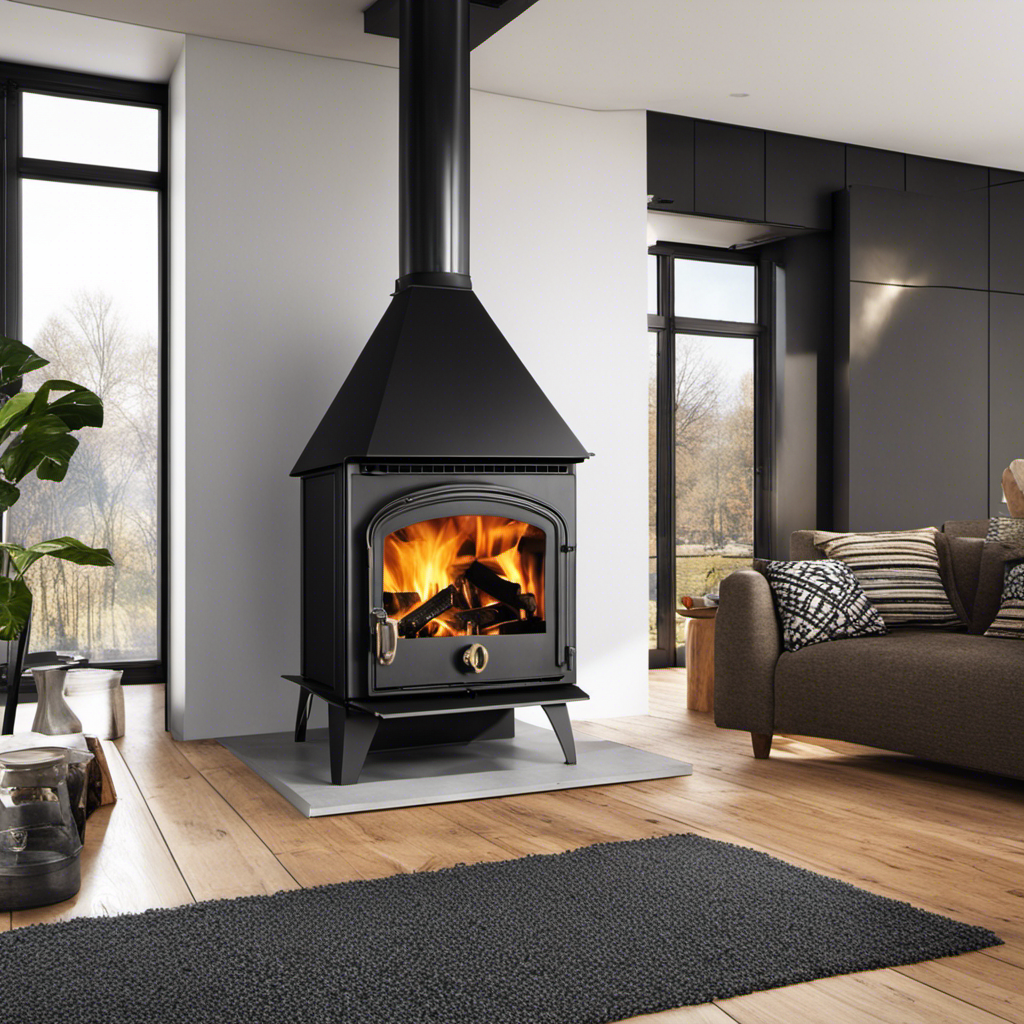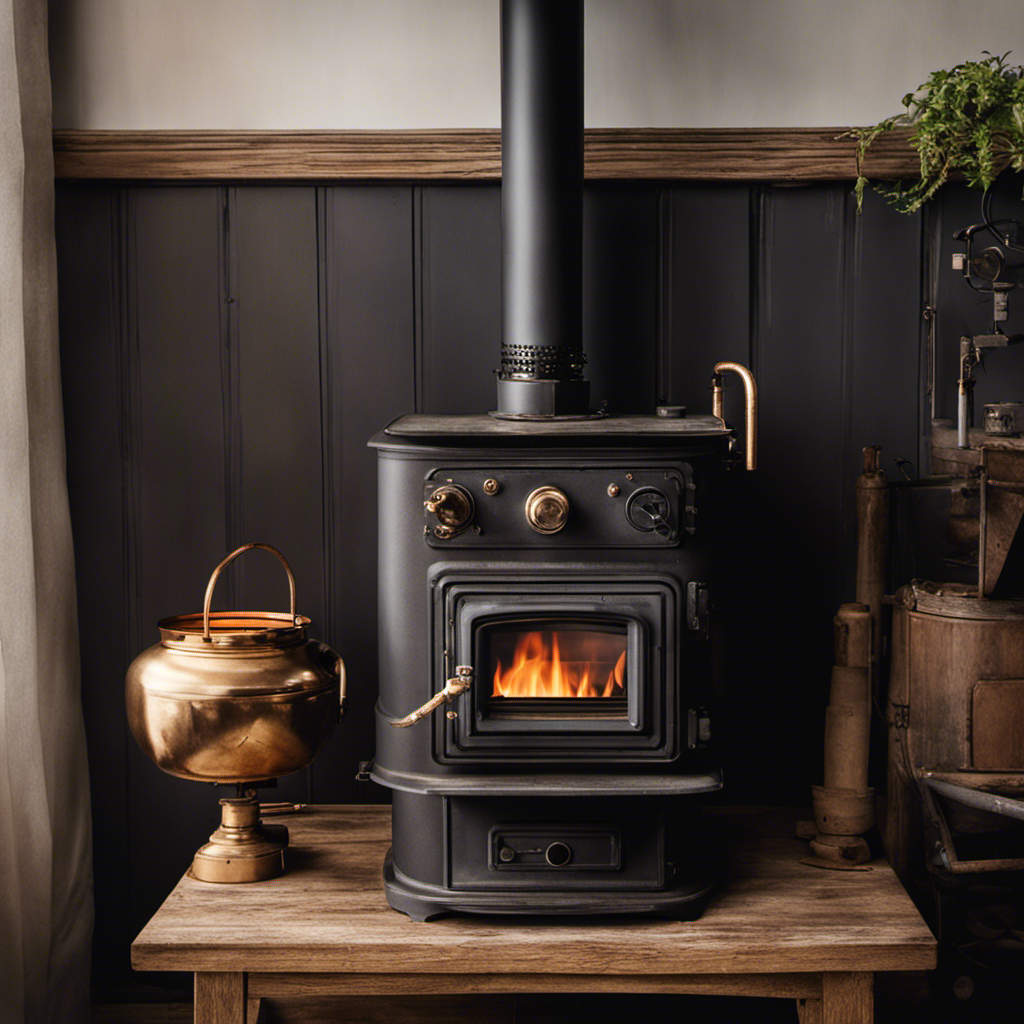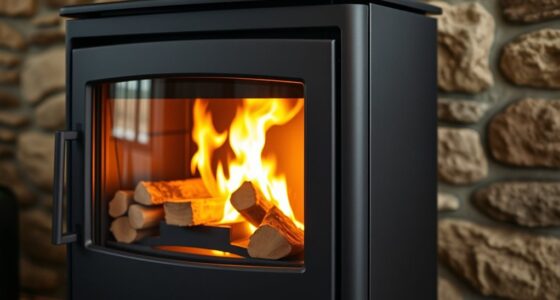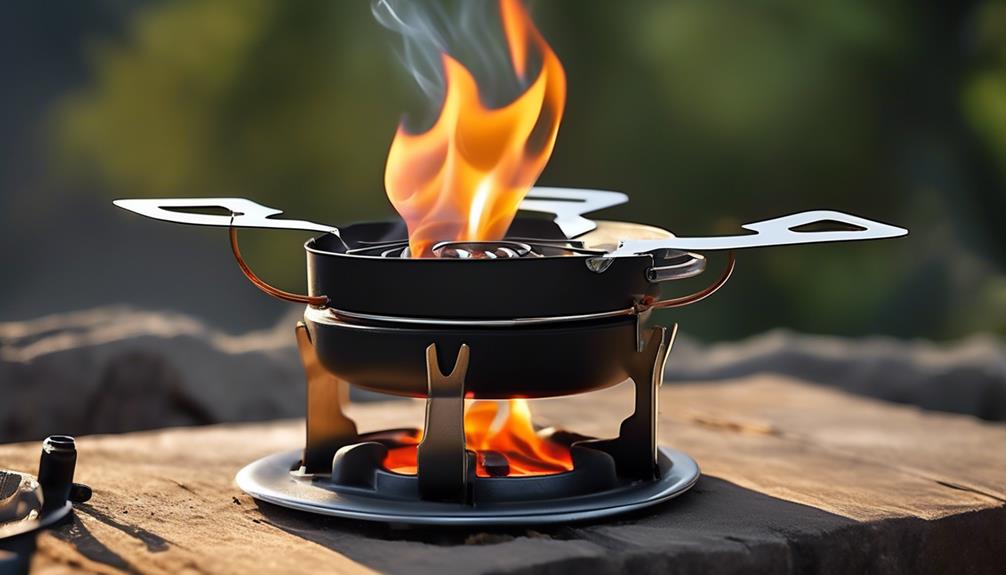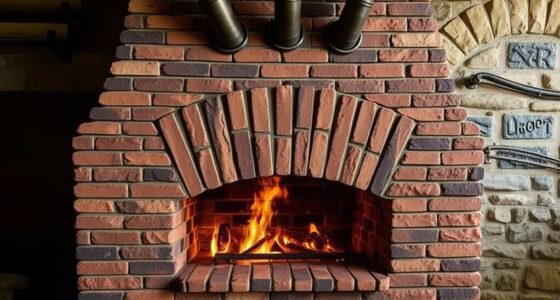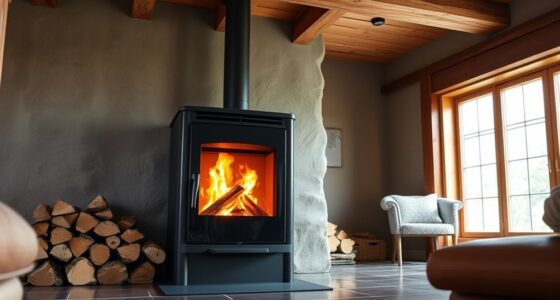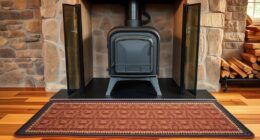I take pride in having built my own wood stove; however, I am now presented with the crucial challenge of selecting the appropriate vent or flue for its installation. Considering the vast array of choices available, exploring the realm of ventilation systems can seem daunting.
In this article, I’ll explore the various types of vents and flues suitable for homemade wood stoves. I’ll also discuss the factors to consider when selecting a flue and the pros and cons of different chimney options.
Plus, I’ll provide guidance on venting options for both indoor and outdoor installations, along with tips for proper installation and maintenance.
Key Takeaways
- The type of vent or flue for a homemade wood stove should be chosen based on factors such as safety precautions, environmental impact, size and diameter, and material.
- Masonry chimneys are durable and provide insulation, but they are expensive and time-consuming to construct.
- Stainless steel chimney pipes are easy to install and maintain, more affordable, but may lack insulation.
- It is important to regularly clean, inspect, and maintain the vent or flue to prevent fires, ensure efficiency, and comply with safety regulations.
Types of Ventilation Systems for Homemade Wood Stoves
I’m considering installing a chimney for better ventilation of my homemade wood stove. When it comes to design considerations for a ventilation system, there are a few factors to keep in mind.
First, the chimney should be tall enough to create adequate draft and ensure proper airflow. Additionally, it should be made of durable materials that can withstand high temperatures and resist corrosion.
Safety measures are crucial when designing a chimney for a wood stove. It’s important to install a chimney cap to prevent debris or animals from entering and to prevent downdrafts. A spark arrestor should also be installed to reduce the risk of fire.
Lastly, regular inspection and cleaning of the chimney are essential to maintain its efficiency and safety.
Factors to Consider When Choosing a Flue for Your DIY Wood Stove
One factor to consider when choosing a flue for my DIY wood stove is its compatibility with the stove’s size and heat output. It’s important to select a flue that can effectively handle the amount of heat generated by the stove to ensure proper ventilation and prevent overheating. Here are four key considerations to keep in mind:
-
Safety Precautions: When selecting a flue, prioritize safety features such as insulation and durability. Ensure that the flue is designed to withstand high temperatures and is properly sealed to prevent any leaks or potential fire hazards.
-
Environmental Impact: Consider the environmental impact of different flue options. Look for flues that are designed to minimize emissions and maximize energy efficiency, such as those with built-in catalytic converters or secondary combustion chambers.
-
Size and Diameter: Choose a flue that’s appropriately sized for your wood stove. The flue should have sufficient diameter to allow for proper airflow and efficient smoke extraction.
-
Material: Select a flue made from durable and heat-resistant materials, such as stainless steel or double-walled insulated pipes. These materials will ensure the longevity and efficiency of the flue system.
Chimney Options for Homemade Wood Stoves: Pros and Cons
The article discusses the various chimney options for homemade wood stoves, outlining the pros and cons of each.
When it comes to chimney installation for a homemade wood stove, there are a few options to consider.
One option is a masonry chimney, which is built using bricks or stone. This type of chimney is durable and provides excellent insulation. However, it can be expensive and time-consuming to construct.
Another option is a stainless steel chimney pipe, which is easy to install and maintain. It’s also more affordable than a masonry chimney. However, it may not provide the same level of insulation as a masonry chimney.
Regular chimney maintenance is essential to ensure optimal performance and safety. This includes regular cleaning to remove creosote buildup and inspections to check for any damage or blockages.
Proper chimney maintenance will help prevent chimney fires and ensure the efficient operation of your homemade wood stove.
Venting Options for Indoor and Outdoor Wood Stove Installations
I’ve been researching the best venting options for my indoor and outdoor wood stove installations. It’s important to ensure proper ventilation for safety reasons and to comply with the regulations for wood stove installations.
Here are four ventilation options to consider:
-
Direct Venting: This option involves installing a pipe that goes directly through an exterior wall, allowing the stove to draw in fresh air for combustion and expel the combustion gases outside. It’s a popular choice for tiny homes as it saves space.
-
Chimney Venting: A traditional option is to install a chimney that extends above the roofline. This allows for proper drafting and ensures that the smoke and gases are safely expelled outside.
-
Power Venting: In situations where a traditional chimney isn’t feasible, a power vent can be used. It uses a fan to assist in the expulsion of the combustion gases, providing an alternative solution.
-
Pellet Venting: For those using pellet stoves, pellet venting systems are designed specifically for these appliances. They provide a safe and efficient way to vent the combustion gases.
When considering ventilation options for your wood stove installations, it’s crucial to consult the safety regulations and guidelines to ensure compliance and the well-being of your tiny home.
Best Practices for Installing and Maintaining a Vent or Flue for Your DIY Wood Stove
After researching the best practices, I found that using a double-walled stainless steel flue with proper insulation is essential for effectively installing and maintaining a vent for my DIY wood stove.
Ventilation techniques play a crucial role in ensuring the safe and efficient operation of a wood stove. The double-walled design of the flue provides increased durability and protection against heat transfer to combustible materials. It also helps to prevent the accumulation of creosote, a highly flammable substance that can build up in the flue over time.
Proper flue maintenance is equally important. Regular cleaning and inspection of the flue, including the removal of any creosote deposits, can prevent chimney fires and ensure optimal performance.
Additionally, installing a chimney cap can prevent rain, snow, and debris from entering the flue, further enhancing its efficiency and lifespan.
Frequently Asked Questions
What Are the Safety Precautions to Take When Installing a Vent or Flue for a Homemade Wood Stove?
When installing a vent or flue for a homemade wood stove, it is crucial to prioritize safety precautions. Proper ventilation is essential to prevent the buildup of carbon monoxide and ensure efficient combustion.
Can I Use an Existing Chimney for My DIY Wood Stove, or Do I Need to Install a Separate Flue?
Using an existing chimney for my DIY wood stove depends on its condition and compatibility. However, for safety reasons, it’s recommended to install a separate flue, ensuring proper ventilation and minimizing the risk of fire hazards.
What Is the Recommended Distance Between the Wood Stove and the Vent or Flue?
The recommended distance between a wood stove and its vent or flue varies depending on the specific stove and local building codes. Safety precautions should always be followed to ensure proper airflow and prevent potential hazards.
Are There Any Specific Building Codes or Regulations That I Need to Follow When Installing a Vent or Flue for a Homemade Wood Stove?
When installing a vent or flue for a homemade wood stove, it is crucial to follow building code requirements and safety guidelines. These regulations ensure proper ventilation and reduce the risk of fire or carbon monoxide poisoning.
How Often Should I Clean and Maintain the Vent or Flue to Ensure Optimal Performance and Safety?
Cleaning frequency and proper maintenance are crucial for optimal performance and safety of your vent or flue. Regular cleaning, such as removing creosote buildup, should be done at least once a year to prevent chimney fires and ensure efficient operation.
Conclusion
In conclusion, when it comes to installing a vent or flue for your homemade wood stove, it’s important to consider the type of ventilation system, factors such as safety and efficiency, and the pros and cons of different chimney options.
Whether you’re installing your wood stove indoors or outdoors, following best practices will ensure proper installation and maintenance.
Addressing any concerns about ventilation will help create a safe and enjoyable wood stove experience.
Growing up surrounded by the vast beauty of nature, Sierra was always drawn to the call of the wild. While others sought the comfort of the familiar, she ventured out, embracing the unpredictable and finding stories in the heartbeat of nature.
At the epicenter of every remarkable venture lies a dynamic team—a fusion of diverse talents, visions, and passions. The essence of Best Small Wood Stoves is crafted and refined by such a trio: Sierra, Logan, and Terra. Their collective expertise has transformed the platform into a leading authority on small wood stoves, radiating warmth and knowledge in equal measure.

